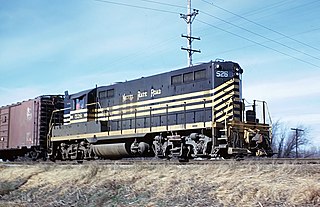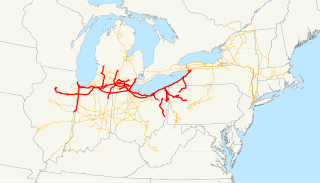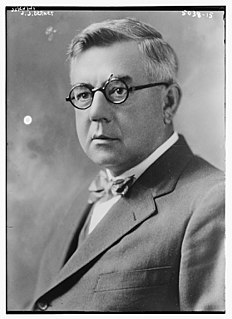Related Research Articles

The New York Central Railroad was a railroad primarily operating in the Great Lakes and Mid Atlantic regions of the United States. The railroad primarily connected greater New York and Boston in the east with Chicago and St. Louis in the Midwest along with the intermediate cities of Albany, Buffalo, Cleveland, Cincinnati, Detroit, and Syracuse. New York Central was headquartered in New York City's New York Central Building, adjacent to its largest station, Grand Central Terminal.
The Pere Marquette Railway operated in the Great Lakes region of the United States and southern parts of Ontario in Canada. It had trackage in the states of Michigan, Ohio, Indiana and the Canadian province of Ontario. Its primary connections included Buffalo; Toledo; and Chicago. The company was named after Père Jacques Marquette S.J. (1637–1675), a French Jesuit missionary who founded Michigan's first European settlement, Sault Ste Marie.

The New York, Chicago and St. Louis Railroad, abbreviated NYC&St.L, was a railroad that operated in the mid-central United States. Commonly referred to as the "Nickel Plate Road", the railroad served a large area, including trackage in the states of New York, Pennsylvania, Ohio, Indiana, Illinois, and Missouri. Its primary connections included Buffalo, Chicago, Cincinnati, Cleveland, Indianapolis, St. Louis, and Toledo.

The Lake Shore and Michigan Southern Railway, established in 1833 and sometimes referred to as the Lake Shore, was a major part of the New York Central Railroad's Water Level Route from Buffalo, New York, to Chicago, Illinois, primarily along the south shore of Lake Erie and across northern Indiana. The line's trackage is still used as a major rail transportation corridor and hosts Amtrak passenger trains, with the ownership in 1998 split at Cleveland between CSX to the east, and Norfolk Southern in the west.

Oris Paxton Van Sweringen and Mantis James Van Sweringen were brothers who became railroad barons in order to develop Shaker Heights, Ohio. They are better known as O. P. Van Sweringen and M. J. Van Sweringen, or by their collective nickname, the Vans. The brothers came from a farming area near Wooster, Ohio. Their father was for a time an engineer in the oil fields of Pennsylvania, fought in the Civil War and was wounded at the Battle of Gettysburg. The family moved to Cleveland, Ohio, in about 1890.

The Boston and Albany Railroad was a railroad connecting Boston, Massachusetts to Albany, New York, later becoming part of the New York Central Railroad system, Conrail, and CSX Transportation. The line is currently used by CSX for freight. Passenger service is still provided on the line by Amtrak, as part of their Lake Shore Limited service, and by the MBTA Commuter Rail system, which owns the section east of Worcester and operates it as their Framingham/Worcester Line.

The Wheeling and Lake Erie Railway is a Class II regional railroad that provides freight service, mainly in the U.S. state of Ohio. It took its name from the former Wheeling and Lake Erie Railway, most of which it bought from the Norfolk and Western Railway in 1990.

The West Shore Railroad was the final name of a railroad that ran from Weehawken, New Jersey, which is across the Hudson River from New York City, north along the west shore of the river to Albany, New York and then west to Buffalo. It was organized as a competitor to the New York Central and Hudson River Railroad, but was soon taken over by that company.
The Cleveland Short Line Railway is a freight bypass around southern Cleveland, Ohio, in the United States. A quasi-independent railroad organized by major shareholders of the Lake Shore and Michigan Southern Railway, the shortline was intended to allow the Lake Shore and Michigan Southern to bypass the congested railroads in downtown Cleveland. The Cleveland Short Line has had a succession of owners, and is currently part of CSX Transportation.

The Pennsylvania Company, later known publicly as the Pennsylvania Lines was a major holding company. It included the Pittsburgh, Fort Wayne and Chicago Railway, the PRR's main route to Chicago. It also owned but did not operate the Pittsburgh, Cincinnati, Chicago and St. Louis Railroad, another line to Chicago. It merged back into the Pennsylvania Railroad in 1918.
In the "Official Territory", the land of the Northeast U.S. bounded roughly by the Mississippi, Ohio and Potomac rivers, one of the most important railroad corridors is between New York City and Chicago. For over a century, this corridor was dominated by four major railroads, and an aggregate of other roads that served as a fifth option.
In addition to streetcar lines, the Van Sweringen Brothers of Cleveland, Ohio owned a vast network of steam railroads.

Cleveland has been and continues to be deeply rooted in railroad history.

John Joseph Bernet was president of the Nickel Plate Road, Erie Railroad, Chesapeake and Ohio Railway and Pere Marquette Railroad in the United States. He was known for bringing railroad companies back from bankruptcy to solvency, earning him the nickname "Doctor of Sick Railroads".

The Toledo, St. Louis and Western Railroad, often abbreviated TStL&W and commonly known as the Clover Leaf, was a railroad company that operated in northwestern Ohio, north central Indiana, and south central Illinois during the late 19th and early 20th centuries.

The Cincinnati Northern Railroad was a railroad that stretched from Franklin, Ohio north to Jackson, Michigan, a distance of about 186 miles (299 km). It was acquired by the Cleveland, Cincinnati, Chicago and St. Louis Railway in 1901 and the New York Central Railroad several years later. Most of the line has since been abandoned.
The Wheeling and Lake Erie Railway was a Class I railroad mostly within the U.S. state of Ohio. It was leased to the New York, Chicago and St. Louis Railroad in 1949, and merged into the Norfolk and Western Railway in 1988. A new regional railroad reused the Wheeling and Lake Erie Railway name in 1990 when it acquired most of the former W&LE from the N&W.
The Hoosier Heritage Port Authority is a quasi-governmental organization in the U.S. state of Indiana. It is the owner of a Heritage railway, operated by the Indiana Transportation Museum, over former Norfolk Southern trackage from Tipton, Indiana, to Indianapolis, a distance of 37 miles (59.5 km). This trackage is the southernmost section of the former Indianapolis to Michigan City main line operated by several railroad companies since its original construction in the mid-19th Century, the best known being the Nickel Plate.
The Nickel Plate Limited, later known as the City of Cleveland and City of Chicago, was a passenger train operated by the New York, Chicago and St. Louis Railroad between Chicago and Buffalo, New York via Cleveland, Ohio, with through service to Hoboken, New Jersey via Binghamton and Scranton and the Delaware, Lackawanna and Western Railroad for the Buffalo-Hoboken segment.
References
- ↑ Rehor, John A. (1994). The Nickel Plate story. Waukesha, WI: Kalmbach Publishing Co. ISBN 0-89024-012-4.